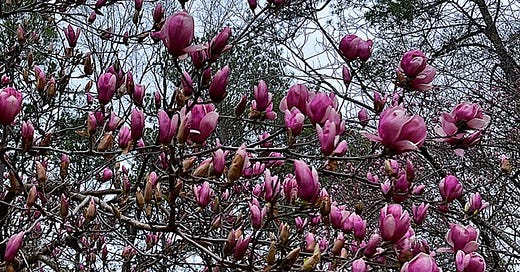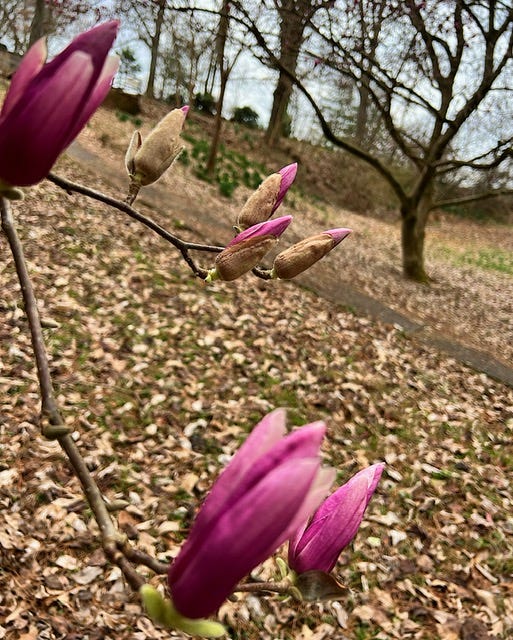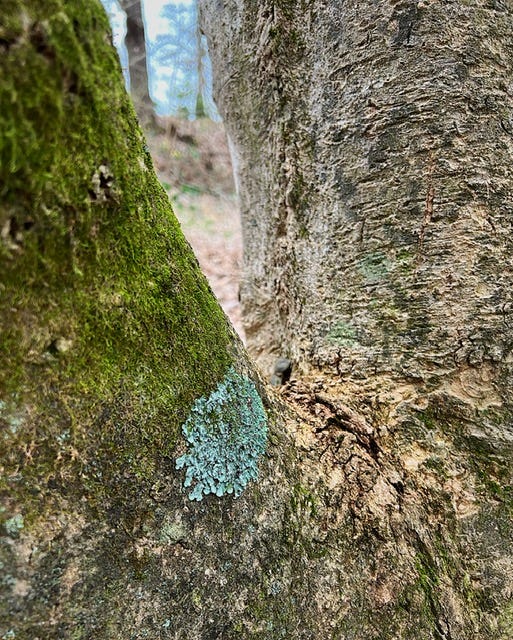I found a tree, in time
I have been struggling with time; at times wrestling with it, trying to shape it like clay into a loving vessel that is something more than a container for hours worked. I am looking for a different relationship with it. I want to inhabit it differently. Collaborate with it. Yet another reason why I come back again and again, to the flower.
Except for a few stalwarts shielded in some way from the sputtering spring rain and wind, the magnolia blooms are long gone. Now, just a few short weeks after those first harbingers pushed up and out—the daffodil, forsythia, and magnolia—Georgia is a riot of bloom. The early risers are lost or forgotten in the chaos. You can look in any direction right now and delight in cherry, pear, plum. Dogwood pink and white. Languid wisteria, and bright yellow creeping jessamine that loops and drapes itself over everything—like forsythia, if it had had a massage and a valium. The redbud have multiplied in their elegant exuberance, opening gorgeous pink arms in unearned welcome to all of us who overcrowd Atlanta and surrounding territories. Tender, yellow green leaves are sprouting, azaleas are airing their fuchsia and pepto-pink petticoats in the sunshine. Everything blowing up. Circus cannons, rolled out in the dark night, have silently fired off candy-colored sprays of petal. In this sped-up reel of blossoming, the pink magnolia flowers I have been obsessed with have already left the stage, pushed off and away by spring’s next act.
So, even as the tree’s green buds are leafing on knarled branches, that flower’s season has passed. I’m glad I found some in time. As I approach my parents’ death anniversaries, the sense of spring-born hope and gentle wonder mingles with an awareness of absence that is sharp and acrid. It felt important to inhabit and breath deeply into that specific space/time: the first, soft opening up of Georgia spring. It felt important to be present enough to receive such a gift on behalf of people that could only be there through me. A pink magnolia in bloom embodies that moment and a few weeks ago, felt like the only company I wanted to keep. It felt like the only living presence patient and kind enough to sit in quiet companionship with me and my watercolor emotions.
I drove across days and miles looking for a pink magnolia to bloom with and had little luck at first. One estimate maps 84% of the land in this country as privately owned. And 96% of the pink magnolia trees apparently. Most of what I can access is a fossil fuel landscape, gas stations and drive-thrus. The strips of woodland that line the road are unattached to any conservation strategy and barely do their sole job of drawing a green curtain of concealment around ubiquitous overdevelopment. There are parks and preserves (including my beloved Arabia Mountain) but of course the most common green spaces out here are just…yards.
In her essay The Foreigner’s Home, Toni Morrison writes:
“There is private space (atriums, gardens, etc.) open to the public. And public space (parks , playgrounds, and beaches in certain neighborhoods) limited to private use. There is the looking-glass phenomenon of the “play” of the public in our private, interior lives. Interiors of our houses look like store displays …and store displays are arranged as house interiors. …Since the space in which both civic and private life is lived has become so indistinguishable from inner and outer, from inside/outside, these two realms have been compressed into a ubiquitous blur, a rattling of our concept of home.”
Morrison is describing the dangers of globalism as opposed to the effects of an isolationist suburban built environment, but there is, I think, a fractal connection that extends to our understanding and practice of “nature.” What do we do when our concept of home involves—requires— the unfettered ability to sit in silence under the branches of and in some kind of curious communion with a blooming pink magnolia tree?
Suburban yards succeed or fail at creating looking-glass versions of gardens, fields and woods that in another world or time one might be ‘free to roam,’ to forage and wander in, to even sit in for a spell, staring up at a charm of finches dotting a grey sky. Instead, we drive by, identifying in passing trees and plants with whom we might be in rituals of communion and remembrance. These rooted beings “belong” to someone, are held in private enclosure. The whole set up makes me feel stunted and weird in my desire to wander, explore, and build relationships beyond the human.
I found trees I could be with in places that Morrison describes as “private spaces open to the public.” I was finally able to sit with a pink magnolia in bloom, on the grounds of the Trappist Monastery near where I live. This tree had adopted symmetry early on, its trunk split neatly in half a couple of feet from the ground.
At some point it had given up on that project and let its asymmetrical, craggy bent knuckles reach up and outward haphazardly. Each cradled a just-opening pink and white bud. I held the tree’s cool, mossy bark with the palm of my hand. One of its tiny, crawling inhabitants found its path across my pinky. We sat back to bark, in still companionship a little while. The geese at the pond down the hill were overreacting to something but it was otherwise quiet. After a bit, when I heard people coming up the path, I thanked the tree for sharing an important moment in its cycle with me. I delivered its well wishes to my mother and father who I hope are dreaming in a loop of spring’s promise.
I was able to gather the buds and blooms for the magnolia syrup I made from the grass beneath a young tree in the yard where my sangha meets. That both private/public locations were sites attuned to spirit is no great surprise. Our souls do not recognize property lines.
***
Where is your soul wandering these days? xx






